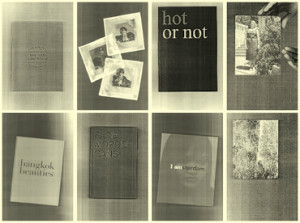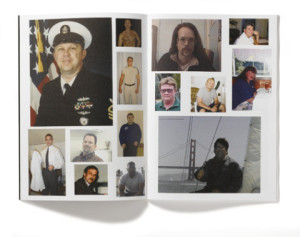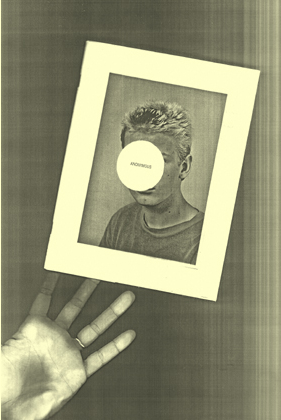Erik Kessels is the founder of KesselsKramer. KesselsKramer is an international communications agency based in Amsterdam, The Netherlands. It has been operational since 1996 and comprises 35 people from 8 nationalities. KK is responsible for creating a range of very diverse work in a variety of media. Campaigns include J&B, the Hans Brinker Budget Hotel, Diesel and Unilever. The agency also produced an internationally awarded film, “The Other Final”, which told the story of a football match between the world’s lowest ranking teams taking place on the same day as the 2002 World Cup Final. As well as advertising, KesselsKramer develops projects for its own imprint, KesselsKramer Publishing. In 2008, KesselsKramer set up London’s KK Outlet, a space which combines a communications agency, gallery space and shop under one roof.
This interview was made on October the 12th in KesselsKramer agency in Amsterdam.
Institute of Network Cultures: Can you tell me something about yourself and about KesselsKramer both as a design studio and as a publishing house? What are the main issues you deal with?
Erik: My name is Erik Kessels and I studied as a graphic designer and art director. We started KesselsKramer, a design and advertising agency, about 25 years ago. I’ve always worked on the visual side of the projects and now, for about 10-11 years, I’ve also been producing a series of books called “I’m in almost every picture” as well as series of magazines called “Useful photography”. We publish these ourselves and for me it is a way to show the things that I’m fascinated about and that I’m curious about. In the company we work for national and international clients. The books that we publish under “KesselsKramer Publishing”, are on subjects that fascinate us. The books that we make for other companies are then published by other publishers.
INC: How do you develop an editorial project?
E: In a way that is very personal. For example, the book series called “I’m in almost every picture” always contains series of photographs by amateurs: I find them online or in flea markets and then I make them into a book because in a certain way I take them out of their original context and then I put them into a new context, giving them another dimension.
 INC: Have you ever done an e-book? Are you planning to make digital publishing in the next years? What are your expectations for the future of publishing?
INC: Have you ever done an e-book? Are you planning to make digital publishing in the next years? What are your expectations for the future of publishing?
E: Some of the existing books are also digitally available but the thing is that most of the content of the book already exists digitally; all I do is take it from its context and make it into a print book again. Sometimes you can also do it the other way round, when you find a good book it is nice to make it digital.When I find something interesting on a market or online, I would not only do a digital book because the material object is very important to me.
INC: Why should a book be digital and why not? What are the main innovation, advantages and disadvantages, of the digital book?
The e-book and the digital book are only there for convenience, to give us easier access to information. But this is something that is also very personal, some people like it more than paper and some people don’t. We are now living in a period where both still exist and we don’t know how things are going to develop, but in a way the e-book is nothing more than a new carrier of the same kind of information, there’s nothing fancy or innovative about that. The thing which is really innovative is that now we have access to a wide range of information, but however, that was also true ten years ago.
INC: Can design and visual art practices inspire and contribute to the research on digital publishing and the e-book as a medium?
E: I think that when everything becomes more crystalized with the e-book and with the digital book, then there will be a period when people start to experiment more freely with it and even go beyond. This will take time, because now is kind of a confusing time with the e-book, in understanding how to use it, how to access it … you never know what happens. These are also all the developmental influences. For example, illustrators and drawers: ten years ago they only used the program illustrator, so all along the streets were these vector drawings, now that is completely gone and people use their hands again and they are more into craftsmanship and then they scan these drawings and put them online again or they use them digitally … but the tactile thing is something that is still important. The tactile aspect also has many opportunities in the digital world, but this has not been totally crystalized yet. Of course, you can have an e-book with certain links but maybe it can be much more tactile.
INC: If you picture yourself making a digital book, how would you manage to keep your visual identity? Which are the main visual (or even tactile) elements of the book that shape your identity?
E: In this case it has to do with a certain idea. I mean, I just made a book on something that I found on flickr and the book is printed on paper, but I would never make that book only in digital format, because it comes from a digital world. When you make a book you really have to do it for a certain purpose, with starting idea that it can focus on.
INC: How has the traditional book changed with the introduction of digital books? Don’t you think it would be better to talk about “reading experience” for both digital and non digital books?
E: The digital book has its own advantages, we should not separate the concepts of digital and analogue or of online and offline. We are living in one world and the way in which one receives information, whether it’s by watching, reading or listening, is not what matters. Nowadays, there are just many more information carriers. What’s most important is the content of what you see, hear and read, whether on paper or digitally, and then of course you can experiment with its forms.
INC: Most of your publishing projects deal with photography, re-appropriation of images and reuse of those images in different contexts and with different meanings. How is the use of images changing with the increased use of digital photography?
E: With the e-book there are many more ways to move an image, however, we have be careful because that can also be totally exhausting. Some people just like to read the book and prefer to read it in words and on paper. It has to come from an idea, the idea is the most important ingredient of anything, of a book, of a campaign, or of a design.
INC: What about the structure of the book, the organization of content, indices, hypertexts etc. or different kinds of narratives? How are all of these things changing?
E: All these new ingredients will expand opportunities and could also influence the idea that people have about books, but that will only happen when it finally becomes more widely used. We are still in a very experimental phase, even though the e-book has existed for some time now, it is still not very commonly used. When the e-book becomes more commonly used, people will really start to experiment with it. This is almost like a second layer of skin: the books on paper have been there for a very long time but it’s only now, in the last few years, that people have started to experiment with different forms in literature. For example, I saw a book that was made in the form of a catalogue and the next to all the stuff showed on it there was a small portion of the whole novel. Last year I made a book with perfume next to it, so you could look at the picture, read the text and also smell it. There are many ways of making a book that appeal to our different senses.
 INC: Do you think that the practices and ways that we interact with books (and through books) are different now? and how? For example, digital libraries and archives, social networks, collaborative practices, self-publishing, etc.
INC: Do you think that the practices and ways that we interact with books (and through books) are different now? and how? For example, digital libraries and archives, social networks, collaborative practices, self-publishing, etc.
E: There is total freedom and democratization in publishing but you see that when you still want to have a strong presence on the market, both with the e-book and the paper book, it all comes down to publicity and distribution. But now there are also many pioneers, and they are increasing the opportunities and possibilities in publishing.
INC: How do you deal with delivery industries? What do you think about the “fight” between big corporations and small circuits? Do you think that internet first, and then the digital book have change the trends?
E: They live in unison with one another: one is like the “big mama” and there are all of these angry kids that are trying to kick down the big mama. I think it’s a very healthy confrontation. But then, for the small independent self-publishers, the publishing of both paper books and e-books are just ways to express themselves and the most important thing is showcasing. In many cases, it is not something they do to earn money. On the other side you have big companies that are only trying to make money, they need to pay thier employees, and that’s a totally different thing.
INC: How do you see the future? Is it an interesting time to be involved in publishing?
E: These times are very eclectic and also very confusing because there are so many possibilities and there is so much accesses to everything, you can see anything, you can do everything … but the ideas are becoming more and more important. The ideas for books, e-books or other, are the most important. The possibilities are already there and the channels already exist, but it’s not everyday that a really good book is made. The ideas are the only real challenge, all the other opportunities have increased in the last few years and they will continue to increase, we haven’t hit the roof yet.



